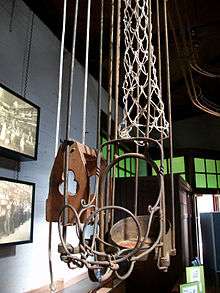Cash carrier

Cash carriers were used in shops and department stores to carry customers' payments from the sales assistant to the cashier and to carry the change and receipt back again.
Cash balls
The earliest type was a wooden ball which ran along sloping rails. One set of rails sloped down from sales desk to cash office and another set sloped in the opposite direction. This was known as a cash railway. William Stickney Lamson of Lowell, Massachusetts patented this system in 1881. His invention soon attracted the interest of other shopkeepers and in 1882 the Lamson Cash Carrier Company was incorporated in Boston. A working example can be seen in the Co-operative store at Beamish Museum in North East England and one is still in its original location in the Up-To-Date Store, now a museum, at Coolamon, New South Wales.
Wire carriers

The next type was a carriage suspended on pulleys from a wire between sales desk, launched from a catapult. The best-known types were "Rapid Wire" and "Air-Line."
Air-Line
The Air-Line Company was based in the United States. It manufactured a Gipe designed system. A cord passed over multiple pulleys to propel the car. Lamsons took over Air-Line and cars usually have "Air-Line" on one side and "Lamson" on the other.
Baldwin Flyer
Baldwin cash carrier systems were usually known as "Baldwin Flyers".
Dart Cash
Dart Cash was a British company established by a grocer from Stoke on Trent, William Alfred Edwards. It was a simple gravity carrier patented in 1918. Later enhancements included a spring for propulsion.
Gipe
Gipe were an American company founded by Emanuel Clarence Gipe of Freeport, Illinois. Gipe installations were popular in England.
Lamson Rapid Wire
Lamsons purchased the Rapid Service Store Railway Company of Detroit which licensed an invention by Robert McCarty of Detroit, Michigan.
Pneumatic tubes
A later type was the pneumatic tube system, still installed in a few shops. Pneumatic tube systems are also now used in supermarkets for moving cash in bulk from tills to the central cash office.
Lamson
The company of Lamson dominated the market - see Lamson tube.
Dart Cash Carriers
As well as wire systems, Dart also made Pneumatic cash carriers.
Sturtevants
Sturtevants of Boston, Massachusetts was an offshoot of an American company. They purchased part of Reid Brothers around the early 1920s and the pneumatic tube business of Cooke, Troughton and Simms. In 1949 they sold up to Lamson.[1]
British Cash & Parcel Conveyors
A British competitor to Lamson which eventually was subsumed.
Notes
- ↑ The Times, 27 April 1950
References
- Buxton, Andrew (2004). Cash Carriers in Shops. Princes Risborough: Shire Publications. ISBN 978-0-7478-0615-8.